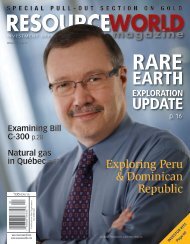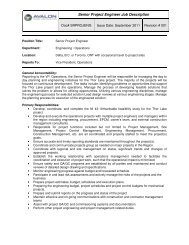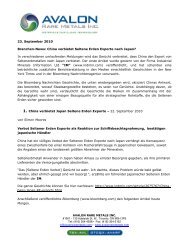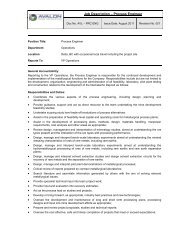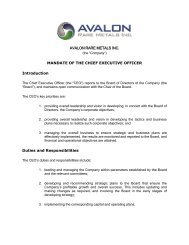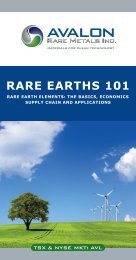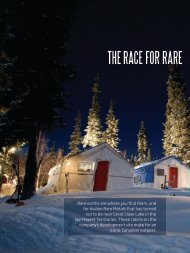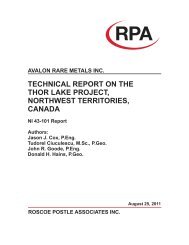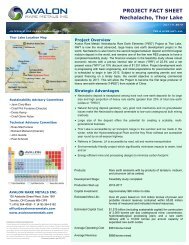technical report on the nechalacho deposit, thor lake project ...
technical report on the nechalacho deposit, thor lake project ...
technical report on the nechalacho deposit, thor lake project ...
You also want an ePaper? Increase the reach of your titles
YUMPU automatically turns print PDFs into web optimized ePapers that Google loves.
feasibility design recommendati<strong>on</strong>s is based <strong>on</strong> geo<str<strong>on</strong>g>technical</str<strong>on</strong>g> logging completed in c<strong>on</strong>juncti<strong>on</strong><br />
with <strong>the</strong> Aval<strong>on</strong> 2009 explorati<strong>on</strong> drill program.<br />
The 2009 explorati<strong>on</strong> drill program at <strong>the</strong> TLP included drilling five (5) HQ diameter drill holes<br />
from each pad positi<strong>on</strong>s. In general, at least two (2) holes from each drill pad were logged by<br />
Aval<strong>on</strong> geological staff. The selected holes covered a range of azimuths in order to reduce<br />
directi<strong>on</strong>al sampling bias. Geomechanical data collecti<strong>on</strong> was focused <strong>on</strong> <strong>the</strong> depth ranges of<br />
greatest interest (20 to 30m into <strong>the</strong> HW, <strong>the</strong> Ore and at least 5 to 10 m into <strong>the</strong> FW).<br />
During <strong>the</strong> 2009 program, Aval<strong>on</strong> geological staff geomechanically logged approximately 2,300<br />
m of core divided am<strong>on</strong>g 22 drill holes. The logging focused <strong>on</strong> ga<strong>the</strong>ring <strong>the</strong> rock mass<br />
characteristics needed to classify <strong>the</strong> encountered rock masses using both <strong>the</strong> Norwegian<br />
Geo<str<strong>on</strong>g>technical</str<strong>on</strong>g> Institute Tunneling Quality (NGI-Q) and <strong>the</strong> 1989 versi<strong>on</strong> of <strong>the</strong> Rock Mass Rating<br />
system (RMR89). These holes were used to assign rock mass characteristics to <strong>the</strong> HW, Ore<br />
and FW.<br />
The results suggest that <strong>the</strong> rock masses encountered at <strong>the</strong> TLP are generally good quality<br />
and that <strong>the</strong>re is little variati<strong>on</strong> with depth. General observati<strong>on</strong>s include <strong>the</strong> following:<br />
• Drill core recovery was c<strong>on</strong>sistently close to 100% suggesting that few z<strong>on</strong>es of reduced<br />
rock mass quality were encountered.<br />
• RQD values were generally in <strong>the</strong> 90 to 100% range.<br />
• RMR values were generally ranged between 60 and 80 and would be typical of a good<br />
quality rock mass.<br />
The rock mass was grouped into domains with similar engineering characteristics. Given <strong>the</strong><br />
relatively minor down hole variati<strong>on</strong>s in rock mass quality and <strong>the</strong> focus of this study <strong>on</strong> <strong>the</strong> rock<br />
masses in and around <strong>the</strong> ore body, it was decided to utilize <strong>on</strong>ly three geomechanical domains:<br />
HW, Ore and FW. A comparis<strong>on</strong> of <strong>the</strong> design values determined for each domain suggested<br />
that <strong>the</strong>y do not vary enough to justify different design values. As such, RMR = 67 and a Q’ of<br />
4.2 were initially selected for pre-feasibility design purposes for all domains. Lower and upper<br />
bound values were also used for certain analyses.<br />
Subsequent review of <strong>the</strong> number of joint sets and <strong>the</strong> rati<strong>on</strong>alizati<strong>on</strong> of <strong>the</strong> design parameters<br />
to <strong>the</strong> expected “good” rock c<strong>on</strong>diti<strong>on</strong>s led to a revisi<strong>on</strong> of <strong>the</strong> Q’ value to 8.3. In additi<strong>on</strong> <strong>the</strong><br />
performance of <strong>the</strong> rock as openings are developed will be used as a guide in <strong>the</strong> final stope<br />
design sizing.<br />
Technical Report 43-101 – March 13, 2011 Page 18-5<br />
Prepared by Aval<strong>on</strong> Rare Metals Inc.





